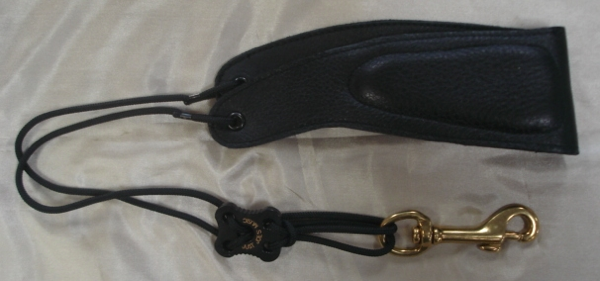A saxophonist can never have too many reeds, nor have too many neck straps. Over the years, I have had a plethora of neck straps, ranging from the Ray Hyman strap, to various no-name padded ones, to that newish Rico Strap, various Neotech Straps, and even the Oleg Ergonomic strap.
They all have their good and bad points (well, most of them). For instance, I love the micro-adjustments you can do on the Hyman strap. It’s a great strap for doing Pit work. The Rico strap is great for playing curved soprano (but sorta sucks for tenor), and the Oleg strap is nice, but it gets one’s neck hot and wet and…..that is just not a good thing. The Oleg strap also is a little funky to adjust, and sorta looks like one of those Texas cowboy tie things.

Enter the Saxophone Gel Strap. I first heard about it when David Valdez had his Neck Strap Smackdown. And paid a little more attention to it when David supposedly talked about it on SOTW (not a good idea usually) and getting so pissed off that he even did a scientific analysis of how the strap enhances the sound of a saxophone (read both the links to get some background on it) and quit SOTW (bravo sir) in disgust. I guess the arm chair philosophers there will have to find someone else to push around!
Anyhow, so, I finally obtained the fabled strap. Was it like the red sea parting? Rays of light piercing through the clouds? Choirs singing Beethoven’s 9th?
The jury is still out about it’s biblical abilities, but I will say these things so far. First, it is THE MOST COMFORTABLE STRAP EVER. It takes what I hated about the Oleg strap, the lack of padding/adjusting it, and fixed it. Fixed it big time. I mean, the Gel Strap looks nearly identical to the Oleg strap if you have them side by side. But the Gel Strap has an awesome level of padding on it. Plus, it is a lot easier to adjust the Gel Strap than the Oleg one. I think it is the thickness of the cords in the Oleg strap and maybe because mine has a lot of wear on it (it’s probably a decade or more old). But the Oleg Strap has never been a panacea for adjustment. I’ve always hated adjusting the height on it. It was just the most comfortable strap to play tenor with. Well, now the Gel Strap is the strap that is the most comfortable and I’m not bitching about the pain in the butt it is to adjust.
Now, the whole “does it make the saxophone sounds better thing”. I have tried it out for several days now (nearly a week), done a rehearsal on it, taught with it on, and did a gig with it. Did I notice a difference? Yes, I did. Though it is very subtle. For instance, the middle D on my alto seems to ring slightly more than if I played it with the Oleg strap. Or the Neotech strap. In fact, I did have the Oleg and the Gel Strap on at the same time, and switched between them. It is there, that little bit of difference. I think what I really need to do is a recording test of it, to see if it is actually something that is audible or if I am just hearing things.
So, verdict? If you want a really nice strap, and were looking at the Oleg strap (which is great), consider the Gel Strap. They are the same price basically. And get the brass hook version. Actually, if in general you are looking for a strap that is comfortable, won’t make your neck break out like it is in a sauna, then get the Gel Strap. It’s probably double the price of a typical Neotech strap, but it is going to last a long long time, and its way more comfortable. It’s worth the extra money.
Great design, love the padding. The cords and slider for adjusting the strap are vast improvements over the Oleg strap, and the cords are thinner and don’t seem to be made of the stuff like the Oleg one (so maybe they will wear better?). And the brass hook provides a solid, authoritative hold on your horn.
10 out of 10.
